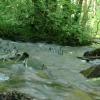
17-06-2016 12:34
 Bernard CLESSE
Bernard CLESSE
Bonjour à tous,Voici un asco que j'ai récemment

15-06-2016 23:13
Salvador TelloHola a todos.Estoy buscando el siguiente artículo

11-06-2016 18:40
 Rubén Martínez-Gil
Rubén Martínez-Gil
Hola a todos. Subo unas fotos de una Orbilia que

16-06-2016 13:06
Peter ThompsonHello Everyone,I have found some pseudothecia embe

16-06-2016 10:09
 Angel Pintos
Angel Pintos
Stromata elongate, containing immersed locules. As
asco sur branche pourrie en bordure de ruisseau
Bernard CLESSE,
17-06-2016 12:34
 Bonjour à tous,
Bonjour à tous,Voici un asco que j'ai récemment trouvé en bordure de ruisseau, sur branche pourrie et imbibée.
a) paraphyses septées, enflées graduellement vers l'extrémité
b) asques IKI-
c) spores elliptiques, biguttulées : 21,5-22x13,5-15
Une idée ?
Bernard
Zuzana Sochorová (Egertová),
17-06-2016 12:55

Re : asco sur branche pourrie en bordure de ruisseau
Hello Bernard,
have you considered Adelphella babingtonii?
Zuzana
have you considered Adelphella babingtonii?
Zuzana
Bernard CLESSE,
17-06-2016 13:44

Re : asco sur branche pourrie en bordure de ruisseau
Hello Zuzana,
No, I had not considered Adelphella babingtonii but I see that this species can be white !! And I found Adelphella babingtonii with its purple hue on the same site there shortly.
So Adelphella babingtonii can have this color?
Thank you for your opinion!
Bernard
Zuzana Sochorová (Egertová),
17-06-2016 14:25

Re : asco sur branche pourrie en bordure de ruisseau
I have never seen so pale fruitbodies in nature, always only brown. But there are some photos of white apothecia on the internet... it can probably vary. I don´t have a better idea than Adelphella.
Nicolas VAN VOOREN,
17-06-2016 18:59

Re : asco sur branche pourrie en bordure de ruisseau
Pour l'amyloïdie, il faudrait vérifier sur des asques vidés, on perçoit généralement plus facilement le bleuissement de la paroi. S'il s'agit bien d'A. babingtonii bien sûr, ce qui semble être le cas au vu des autres caractères microscopiques.
Bernard CLESSE,
17-06-2016 19:11

Re : asco sur branche pourrie en bordure de ruisseau
OK Nicolas, je regarderai sur des asques vides !
Merci pour ton intervention,
Bernard
Merci pour ton intervention,
Bernard
Gilbert MOYNE,
17-06-2016 19:31
Re : asco sur branche pourrie en bordure de ruisseau
Il ne te reste qu'à vider les asques...
Bon courage mais ça ressemble bien à une forme décolorée d'Adelphella babingtonii. Tu peux vérifier l'excipulum aussi.
Gilbert
Bon courage mais ça ressemble bien à une forme décolorée d'Adelphella babingtonii. Tu peux vérifier l'excipulum aussi.
Gilbert
Bernard CLESSE,
17-06-2016 19:41

Re : asco sur branche pourrie en bordure de ruisseau
Merci Gilbert !
Bernard
Bernard



